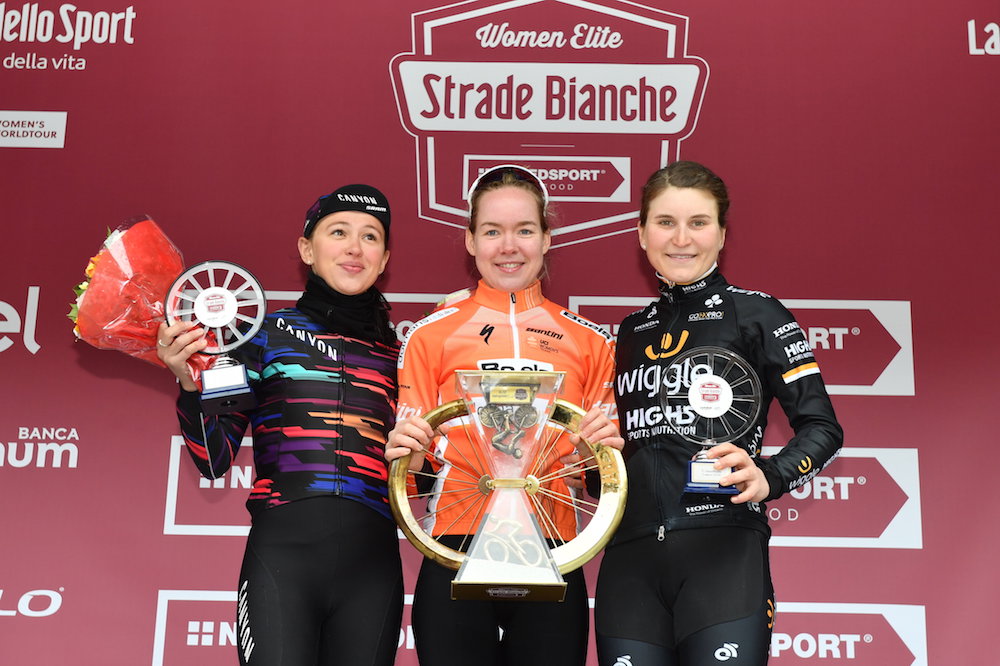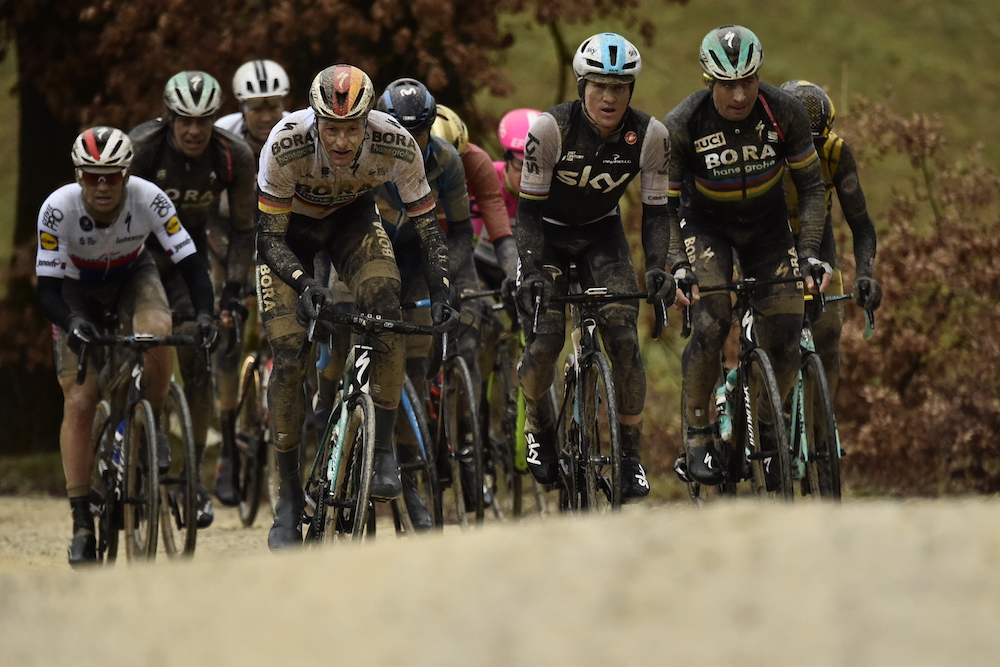Five talking points from Strade Bianche 2018
It was a memorable and brutal edition of the Italian Classic

Tiesj Benoot opens his account spectacularly
https://www.youtube.com/watch?v=G1ZQHjVgHSc
First professional wins aren’t usually as spectacular as this.
Tiesj Benoot (Lotto-Soudal) came out on top in a freezing cold, mud-caked Strade Bianche that will live long in the memory, crossing the line covered in dirt and wearing a haggard expression that epitomised why this race is so well loved.
>>> Tiesj Benoot puts in super show of strength to win 2018 Strade Bianche
His win can be credited to an effective combination of boldness and strength. He attacked early with Pieter Serry (Quick-Step Floors) while all the other major favourites dallied, then proceeded to drop Serry, catch the leading duo of Romain Bardet (Ag2r La Mondiale) and Wout van Aert (Veranda’s Willems-Crelan), and eventually drop them and solo the final 12km to the finish.
That Benoot had never won a pro race before was a surprising statistical quirk for a rider who has been regularly in the mix in several Classics since first announcing himself with fifth at the 2015 Tour of Flanders.
The latest race content, interviews, features, reviews and expert buying guides, direct to your inbox!
To open his account with as big a race as Strade Bianche, and to do so in such emphatic style, is a sign of his star quality.
Aged just 23 and with his whole career ahead of him, it will surely be the first win of many.
Anna van der Breggen now also dominating the spring Classics

Anna van der Breggen (Boels-Dolmans) has already won a sizeable portion of the world’s biggest races, adding two Giro Rosas, La Course, the Ardennes treble, two European titles and the Olympic gold medal to her palmarès before even turning 28-years old.
One area she has not been prolific in, however, are the early season spring Classics, having only won one WorldTour-ranked northern Classic (the 2015 Omloop Het Nieuwsblad) to date.
>>> Anna van der Breggen solos to Strade Bianche 2018 victory
That looks set to change this year. Despite not having raced on the road at all this year, Van der Breggen absolutely trounced the opposition at Strade Bianche, going clear with Elisa Longo Borghini (Wiggle-High5) on the penultimate gravel section, and leaving her Italian companion behind for the final 17km to solo to victory.
The torrid conditions made the win extra special and showcased Van der Breggen’s adaptability to tough conditions, while the margin of victory suggests she’s starting the season on stellar form.
The Dutchwoman will now be eyeing up the upcoming Classics, including her home race the Ronde van Drenthe and the Tour of Flanders.
Strade Bianche is perhaps the most diverse race on the calendar

That Romain Bardet (Ag2r La Mondiale), a Tour de France contender, and Wout Van Aert (Veranda’s Willems-Crelan), the cyclocross world champion, spent so much time together at the front of the race was the perhaps the clearest example yet of just how strange and unique a race Strade Bianche is.
>>> ‘It’s pure cycling’: Romain Bardet and Wout van Aert flourish on Strade Bianche debuts
The two formed an unlikely breakaway duo when they escaped from the peloton on the eighth sector of dirt roads, and, despite their wildly different racing backgrounds, worked well together for over 40km, managing to hold off every chaser apart from Benoot, to pick up second and third.
For Bardet, whose descending and technical skills are already well-noted, his comfort in the extreme conditions and the muddy roads riding a debut Strade Bianche further marks him out as much more than just a climber.
For Van Aert, who was also making his debut, the ride was proof of what was hinted at last week at Omloop Het Nieuwsblad - that the cyclocross superstar can make a similar impression on the road.
Although he betrayed his lack of experience over such a long distance when having to dismount on the final climb to the finish, Van Aert nevertheless rode superbly all day and looked very much in his element in a race that feels a bit like a road race/cyclocross hybrid.
What he does for the rest of the spring will be fascinating to watch.
Big names miss the moves in the men’s race

The women’s race featured the usual suspects at the race’s endgame, with winner Van der Breggen among the pre-race favourites, Kasia Niewiadoma (Canyon-SRAM) finishing second for the third successive year, and last year’s winner Elisa Longo Borghini (Wiggle-High5) rounding off the podium.
But most of the riders expected to be at the forefront of the men’s race found themselves out of contention early on.
There was no sign of last year’s runner-up Greg Van Avermaet (BMC) and 2011 winner Philippe Gilbert (Quick-Step), both apparently missing a large selection made early in the day.
Then, when the key moves went during and after the decisive eighth sector, they did not include the likes of Peter Sagan (Bora-Hansgrohe), Michał Kwiatkowski (Sky), Zdenek Stybar (Quick-Step Floors) and Alejandro Valverde (Movistar) - although the latter did recover later to finish fourth.
Instead, some exciting new names played key roles - Wout van Aert, of course, but also 22-year old Australian Robert Power (Mitchelton-Scott), who showed considerable potential in helping to instigate a small chase group towards the end, and sealed a sixth place finish.
Muddy conditions favoured early moves

As well as providing a sensational spectacle for fans and a brutally unforgettable experience for the riders, the muddy conditions also significantly influenced how both races played out.
The most obvious effect was that the key selections were made early.
In the women’s race, the eventual podium finishers (Van der Breggen, Niewiadoma and Borghini) all broke clear around 20km left to ride making for an unusually small selection so far out from the finish. Then Van der Breggen broke clear for the win, bucking the trend of the last two editions that have ended in sprints up the final climb.
In the men’s race, it wasn’t just pure strength that won Benoot the race - it was also his foresight to make a move early.
The strongest rider on the race was probably Valverde, based on the way he came from nowhere at the end to catch up to and outsprint remnants of chase groups, as well as the way he dropped his breakaway companions with apparent ease in an earlier failed escape group.
He and other riders who got into moves early on - including Kwiatkowski - would have benefited from pressing on, while those who didn’t - like Sagan and Stybar and - needed to be more proactive.
Stephen Puddicombe is a freelance journalist for Cycling Weekly, who regularly contributes to our World Tour racing coverage with race reports, news stories, interviews and features. Outside of cycling, he also enjoys writing about film and TV - but you won't find much of that content embedded into his CW articles.